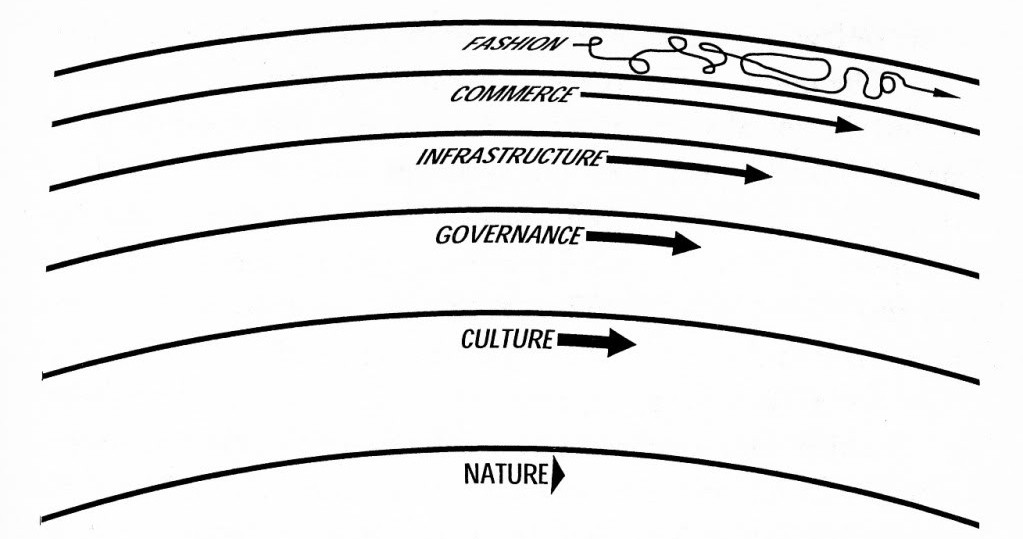Will #coworking exist in 10 000 years? Slow the pace, it’s not a race
Technology has accelerated the speed at which we are living and communicating with each other. Just like a Twitter feed, what happened yesterday is already old news. Sometimes we need to stop and mull things over to have a wider perspective. Recently, while reading the book The Clock of the Long Now by Stewart Brand, I came across one of its best known diagrams, which I believe could help us analyse or look back on the last 10 years of the coworking movement. Stewart Brand separates civilisation into six different layers, each of which changes at its own speed. For example, there is a significant gap between the almost ethereal tempo at which fashion moves and the rhythm of nature.

Pace Layering. Source: The clock of the long now.
Over recent years, the coworking movement has significantly gained momentum and the question is often asked as to whether this "hype" is positive or if it could negatively affect the sustained/sustainable growth of coworking spaces, culture and coworking community.
Do you remember cybercafés? If you were to ask a 15-year-old, I doubt they would know what you're talking about, but there were loads of them back in the day. The introduction of home broadband had a great impact on their model. Models such as Blockbuster didn't know how to respond to the Internet boom either.
Stewart Brand is co-founder of the Long Now Foundation, which mainly considers fostering long-term responsibilities for human kind. In this scenario, they have projects such as the 10 000 year clock or using genetic engineering to clone a mammoth.
- What percentage of the population will be working in 1 000 years' time?
- How much of the active population will be employed and how much of it will be freelance?
- How many cities/planets will a person born in 2 000 years live in?

- Work environment: a shift from an employee culture to "self-driven" people, end of the work/life balance, mobility.
- Changes to city models: independence on transport methods, new housing models, redefinition of public space.
- Consumer models: increase in shared economy, more efficient and rational resource usage models.
- Family environments: changes to traditional models, coliving, family conciliation.
Do you think that coworking will exist in 10 000 years' time?
Related posts
-
10 Award-winning Coworking Space Designs: A Comprehensive Guide
Vibrant, contemporary workspaces create an undeniable ‘wow’ factor. Textured designs and ambient lighting make spaces feel warm and cosy, while natural elements and biophilic design features have literal mood-boosting properties.
-
The Power of People: Building a World-Class Team in Coworking
Coworking spaces thrive on the “co” – the collaborations, connections, and community – that can be formed within a flexible workspace. In fact, community activation is what transforms shared workspaces from mere buildings into vibrant, thriving hubs that empower people in their professional lives and create meaningful community experiences.
-
6 Powerful Storytelling Techniques to Elevate Your Coworking Space
If you've been reading about coworking space design recently, you've probably come across an article or two that mentions narrative design and wondered what exactly it is and how it differs from traditional interior design, as well as how it can be used to improve design.
-
How Local Coworking Spaces Become Catalysts for Community Impact
Imagine swapping the 2-hour commute for a 15-minute bike ride to the office – what would you do with the time you’ve saved? You might use it to build a growing network of neighbours, spend more quality time with family, or even volunteer with a local organisation, becoming more deeply rooted in your community.
-
Niche Coworking Spaces: New Opportunities for Specific Industries in 2025
As demand for coworking continues to grow, niche coworking spaces stand out. Catering to the specific needs of distinct professional communities, these specialised workspaces go beyond just offering a desk and Wi-Fi. In fact, they provide tailored environments, resources, and networks enabling professionals to thrive in their respective fields. This article explores the opportunities these niche coworking spaces offer in various industries in 2025.
-
Evolving Needs of Flex Space Occupiers
Flex space industry growth has undeniably been accelerated by a major shift towards more flexible work models. Last year, 45% of office workers were hybrid, splitting their time between home, the office, and third places, reports Ipsos Karian & Box. Times are changing, bringing new expectations around the purpose of the office. At GCUC UK London, the panel discussion: “Evolving Occupier Needs in the Flex Space Market,” offered valuable insights into the transforming expectations of flex space occupiers. This article shares some of their conversations while exploring this topic further.